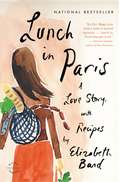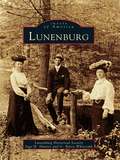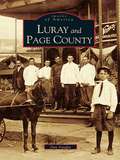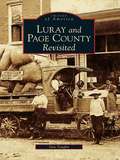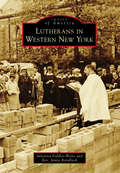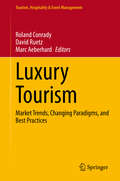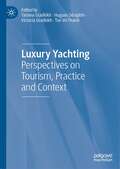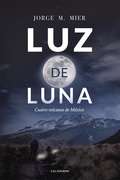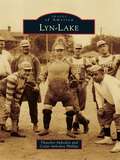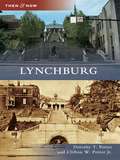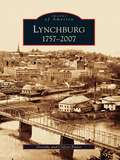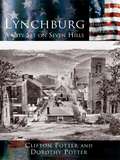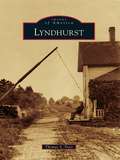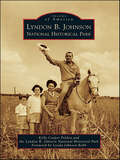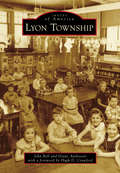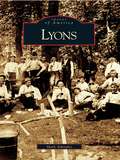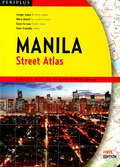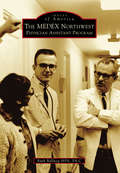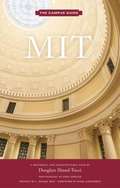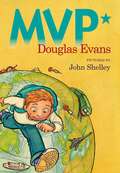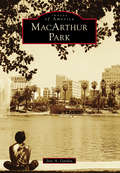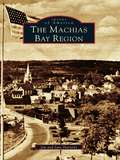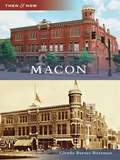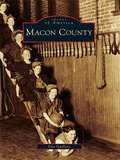- Table View
- List View
Lunch in Paris: A Love Story, with Recipes
by Elizabeth BardIn Paris for a weekend visit, Elizabeth Bard sat down to lunch with a handsome Frenchman--and never went home again. Was it love at first sight? Or was it the way her knife slid effortlessly through her pavé au poivre, the steak's pink juices puddling into the buttery pepper sauce? LUNCH IN PARIS is a memoir about a young American woman caught up in two passionate love affairs--one with her new beau, Gwendal, the other with French cuisine. Packing her bags for a new life in the world's most romantic city, Elizabeth is plunged into a world of bustling open-air markets, hipster bistros, and size 2 femmes fatales. She learns to gut her first fish (with a little help from Jane Austen), soothe pangs of homesickness (with the rise of a chocolate soufflé) and develops a crush on her local butcher (who bears a striking resemblance to Matt Dillon). Elizabeth finds that the deeper she immerses herself in the world of French cuisine, the more Paris itself begins to translate. French culture, she discovers, is not unlike a well-ripened cheese-there may be a crusty exterior, until you cut through to the melting, piquant heart. Peppered with mouth-watering recipes for summer ratatouille, swordfish tartare and molten chocolate cakes, Lunch in Paris is a story of falling in love, redefining success and discovering what it truly means to be at home. In the delicious tradition of memoirs like A Year in Provence and Under the Tuscan Sun, this book is the perfect treat for anyone who has dreamed that lunch in Paris could change their life.
Lunenburg
by Inge H. Hunter Lunenburg Historical Society G. Barry WhitcombThe name "Luneburg" was coined for King George II of England, who was also the duke of Luneburg, Germany, in 1727. The final name, Lunenburg, was probably a result of misspelling in the early records of the town. On August 1, 1728, Lunenburg was officially granted township but, as early as 1726, a variety of industries had been started and twenty-six houses had been built. In the late nineteenth century, the town returned to predominately agriculture and, today, is a rural residential community for industries in neighboring cities. Through a diverse collection of vintage images, Lunenburg will take you on a historical journey through the town's engaging past. Within these pages, you will see photographs of the early businesses that were established, such as bookbinders, blacksmiths, furniture makers, and shoe manufacturers; you will visit many homes, churches, schools and government buildings; and you will experience the daily lives of residents during this exciting time in history.
Luray and Page County (Images of America)
by Dan VaughnFormed out of necessity in 1831, Page County had a great need to operate within its own boundaries of the Massanutten and Blue Ridge Mountains. A very unique situation arose when this rural area was coupled with the discovery in 1878 of something as spectacular as the Luray Caverns. Along with this new fame followed a large influx of tourists, industry, and varied commerce into the entire county from the lifeline created by the formation of the Shenandoah Valley Railroad in 1881. During the reconstruction years after the Civil War, and with the formation of "land and improvement" companies throughout the United States, Page County, along with the rest of the country, was booming. In fact, this unbridled growth was happening much too fast for this newly reformed country. This in turn brought about a severe recession in the 1890s that affected everyone, including the people of Page, no matter how secure they may have seemed with their new attraction. The culmination of these events initiated a quaint photographic history that is contained within the pages of Images of America: Luray and Page County.
Luray and Page County Revisited
by Dan VaughnLuray Caverns, discovered in the quiet valley community of Luray in 1878, became the main attraction in Page County. In hopes of capitalizing on this new found "Wonder of the World," executives of the Shenandoah Valley Railroad completed the rail from Hagerstown and Basic City to Luray by 1881. Mann Almond drove the final ceremonial spike just north of Deford's Tannery in Luray. With the arrival of the railroad came a new economy supported by passengers, excursionists, lodging, and freight transport. The bulk of these transports were Eureka Mining Company's mineral extractions and Shenandoah's "BigGem" iron bloom shipments. Luray's own "Mercantile Mile" leading to the caverns was laden with storehouses, offering goods found in larger cities, and the rail brought visitors in droves. The photographers who produced the images contained here did so only as a means of income, but today their work is our visual link to the past.
Lutherans in Western New York
by Julianna Fiddler-Woite Rev Jamie RetallackDuring the construction of the Erie Canal in the early 1820s, the population of Western New York increased 145 percent. Many of these pioneers were European immigrants, with a high concentration hailing from the German-speaking states. These immigrants brought their Lutheran ideals and continued to practice the religion in their new homeland. By 1827, the first official Lutheran church in Erie County had been incorporated as the German Reformed Church, known today as St. Paul's Lutheran Church in Eggertsville. Soon after, the need for mission churches arose, and by the mid-1800s, Lutheran congregations had been established in several Western New York suburbs. During the following century, the Lutherans in Western New York would undergo growth and change. While all congregations eventually abandoned German as their primary language, many struggled to further separate from their German roots during the Nazi regime. Today, there are nearly 200 Lutheran congregations in New York.
Luxury Tourism: Market Trends, Changing Paradigms, and Best Practices (Tourism, Hospitality & Event Management)
by Roland Conrady David Ruetz Marc AeberhardOver the past two decades, through unprecedented levels of prosperity and changing values, luxury tourism has transformed into a new consumption pattern. This book analyzes the topic in detail with contributions from both recognized scientists and prominent executives in the luxury business. It shows how the concept of luxury has shifted from material to immaterial dimensions, and outlines new trends that will shape the luxury market in the future. The content includes carefully selected leading examples from the most important segments of the tourism market, along with concrete recommendations and best practices. Sharing unique insights, the book is a must-read for those working in the tourism industry, as well as lecturers and university students of tourism.
Luxury Yachting: Perspectives on Tourism, Practice and Context
by Tatiana Gladkikh Hugues Séraphin Victoria Gladkikh Tan Vo-ThanhThis book offers an insight into the luxury yacht industry as a provider and facilitator of a luxury yacht experience. Linked to special interest tourism (SIT), luxury yachting is an exclusive area of tourism and practice which operates in a relatively small and niche environment. Part I offers a range of academic contributions on luxury yachting from a tourism perspective. Part II provides an insight into the industry from the practitioner perspective. Part III stimulates discussions around yachting practices in different destinations. With a truly global outlook, this contributed volume enhances our understanding of a lucrative area within tourism that has so far been under-researched and under-explored.
Luz de luna: Cuatro volcanes de México
by Jorge M. MierEscalar los volcanes de México me ha obligado a cambiar la mirada, a observarlo todo bajo otra luz, mientras caminaba con ellos en la oscuridad. Luz de luna es la crónica de una aventura. Jorge M. Mier, inspirado por su profesor, el conocido cronista y articulista Martín Caparrós, salió en busca de historias y encontró algo que contar. <P><P>Se trata de un trabajo literario que retoma las enseñanzas de los grandes escritores del «nuevo periodismo» americano y que coloca a su autor en el centro de los hechos. Escribiendo sobre su escalada en los volcanes más altos de México, Mier nos acerca al alpinismo en el país, dando voz a unos personajes que se dibujan solos y que, en su lucha por ser profesionales de este deporte, muestran sus virtudes y sus carencias, sus inquietudes y sus miedos y, sobre todo, su gran valor humano. <P><P>En esa aventura se descubren también unos volcanes llenos de misticismo, con nombres que nacen de mitos y leyendas de las culturas que dominaron el continente antes de la llegada de los españoles.
Lyn-Lake (Images of America)
by Thatcher Imboden Cedar Imboden PhillipsThe Lyn-Lake area of Minneapolis, centered around the intersection of Lyndale Avenue and West Lake Street, is one of the city's most distinctive neighborhoods. The core commercial district is one of the oldest in South Minneapolis, thanks in part to its strategic location along several early streetcar lines. A rail line along Twenty-ninth Street, now the Midtown Greenway, brought an industrial element to the neighborhood and provided additional jobs for the thousands of residents who lived in the surrounding houses and apartment buildings. As the neighborhood evolved, it took on a distinctive bohemian bent and filled with a diverse mix of artists, musicians, and writers living side by side with blue-collar industrial workers, along with those who worked at professional office jobs downtown. Lyn-Lake retains its unique flavor today, characterized by its blend of both the historical and the cutting edge.
Lynchburg
by Clifton W. Potter Jr. Dorothy T. PotterSince its beginning as a ferry crossing in 1757, the city of Lynchburg has covered the hills that rise above the James River. A community that has managed to successfully blend its past with the best that the present has to offer, Lynchburg is truly the "Heart of Virginia." Holding doctorates in history, authors Dorothy T. and Clifton W. Potter Jr. have spent their professional careers teaching at Lynchburg College.
Lynchburg: 1757-2007 (Images of America)
by Dorothy Potter Clifton PotterIn the spring of 1757, the Lynch brothers established a ferry across the James River to transport settlers on their way to the Ohio Valley. Within a decade, the settlement clustered around the ferry house became known as Lynchburg. For a century, the city was regarded as one of the most important transportation centers in the Upper South, although its real fortune lay in tobacco. After the Civil War, Lynchburg evolved into a manufacturing center with a broadly based economy. As it marks its 250th anniversary, Lynchburg has become a focus for higher education and tourism in Central Virginia. From the development of the modern camera to the current digital revolution, this photographic record of Lynchburg and the surrounding counties' growth is rich, varied, and traces their transformation almost from their birth to the present day.
Lynchburg: A City Set on Seven Hills
by Dorothy Potter Clifton PotterOnce the primary hunting ground of the Monocan Indians and later a harmonious common area shared with the Quakers, Lynchburg was a crossroads for various cultures even before its founding following the French and Indian War. With roots in the prosperous tobacco fields, the City of Seven Hills became one of the nation's wealthiest communities by the Civil War. During the robust and arduous times to come, Lynchburg continued to thrive by developing diverse industries and eventually becoming a respected educational center.
Lyndhurst
by Thomas S. TreerMoses Cleaveland was sent to survey the lands of the Western Reserve of Connecticut into townships in 1796. Due to a strike, the surveyors were given plots within the new Euclid Township as part of their compensation. They sold these plots to arriving settlers from the east. Aristarkus and Sarah Brainard, the area's first family, arrived in 1831. In 1877, the Mayfield Plank Road was constructed allowing a steady stream of people and goods to easily travel from eastern farms to markets found at Doan's Corners in Cleveland, Ohio. As this part of Euclid Township grew, the area became Euclidville Village, later changed to Lyndhurst Village in 1920. The post-World War II building boom brought many young families to Lyndhurst and transformed the sleepy village into a charming 21st-century suburb.
Lyndon B. Johnson National Historical Park
by Kelly Carper Polden Lyndon B. Johnson National Historical Park Lynda Johnson RobbPres. Lyndon B. Johnson took pride in his heritage and in the Texas Hill Country roots of his pioneer ancestors. He delighted in showing guests the ancestral settlement, and his birthplace, boyhood home, and the family treasure: the LBJ Ranch and the home that became known as the Texas White House. LBJ generously gifted these cherished assets to the people of the United States. Lyndon B. Johnson National Historical Park holds more assets significant to an American president than any other U.S. presidential site. Visitors may stroll through the Johnson Settlement, stepping back in time to the 1860s, when President Johnson�s ancestors helped settle Johnson City, which was named after James Polk Johnson, nephew to LBJ�s grandfather. The Boyhood Home and Visitor Center are located close to the Johnson Settlement, and visitors can tour the reconstructed Birthplace and enjoy a scenic drive through the LBJ Ranch before touring the Texas White House. This book illustrates the significance of LBJ�s heritage and the circle of life represented by what is both a birthplace and a final resting place.
Lyon Township
by John Bell Hugh D. Crawford Diane AndreassiLyon Township and the unincorporated hamlet of New Hudson are nestled in the southwest corner of Oakland County. They have a rich history of agricultural production. Early 20th-century records show that farmers and families socialized closely with their neighbors in the nearby village of South Lyon when the hard work of the day was done. New Hudson supported two general stores, a tavern, a post office, schools, and churches. However, the start of the I-96 expressway in the 1950s took commuters off the streets and away from local businesses, causing some to close. By the 21st century, the tides turned again, when the proximity to the expressway brought attention to the community and heralded in a new construction boom, earning Lyon Township the distinction in 2012 as one of Michigan's fastest-growing communities.
Lyons
by Mark AthitakisDespite its modest size, the village of Lyons has played a key role in the growth of nearby Chicago. In 1673, French explorers Fr. Jacques Marquette and Louis Joliet learned of a Native American portage route connecting the Mississippi River and Lake Michigan, and that path helped make Lyons an important stop for fur traders and other businessmen throughout the 18th and early 19th centuries. In 1834, the town boasted just "a saw mill, three houses, and a tavern," but by the 1830s and 1840s, with the construction of the Illinois and Michigan Canal, Lyons became a boomtown that attracted waves of immigrants from Poland and Germany. Its numerous taverns and outdoor picnics--known as "skillies"--attracted visitors from throughout thearea, who also came to sites like the Cream City Amusement Park and the Hofmann Tower, now a national historic landmark. Lyons, featuring many archival photographs never previously published, explores the town's rich history from its early exploration to the present day.
L’Afrique de l’Est à l’Ouest
by Peter BoehmL’AFRIQUE DE L’EST À L’OUEST, récit de voyage Peter Boehm traverse l’Afrique dans des quatre-quatre roulant à toute vitesse, des cars bringuebalants et des trains fichus. En presque six mois, il traverse neuf pays en parcourant plus de dix mille kilomètres : Somalie, Djibouti, Éthiopie, Soudan, Tchad, Nigeria, Niger, Mali et Sénégal. Ce voyage était long à couper le souffle, énervant mais pas ennuyeux. Les personnes qu’il a rencontrées étaient intéressantes, bizarres et émouvantes, mais elles ne font ni froid ni chaud à personne. Peter Boehm fait le portrait des psychiatres de Somalie qui considèrent toute la population nationale comme des fous - ainsi que les Somaliens eux-mêmes et même l’auteur à la fin ! Au Soudan, il rencontre des médecins qui « referment » les femmes ; au Tchad, des enfants de la rue qui sont fin prêts pour l’Allemagne ; au Mali, des guérisseurs traditionnels qui sont également médecins de famille, Dr Sommer et Kummertante ; au Nigeria, des chefs traditionnels devant qui les sujets s’agenouillent et des juges islamiques qui goûtent, comme du vin gouleyant, aux coups de fouets ordonnés par eux. En supplément, Peter Boehm a exactement suivi le protocole de l’Européen que l’Afrique embrouille et transforme. Peter Boehm emploie un ton laconique et sobre de toute fausse sensiblerie. Comme vous n’en avez jamais lu sur l’Afrique.
MANILA Street Atlas
by Periplus EditorsComprehensively covered in three scales: 1:10,000, 1:15,000, 1:40,000
MEDEX Northwest Physician Assistant Program, The (Images of America)
by Ruth Ballweg MPA PA-CThe MEDEX Northwest Physician Assistant Program was created at the University of Washington in 1968 as one of the nation's first physician assistant (PA) programs. A joint project of the Washington State Medical Association and the University of Washington School of Medicine, MEDEX was designed to meet the needs of overworked physicians in rural communities. As envisioned by MEDEX founder Dr. Richard A. Smith, "Physician Assistants were created by physicians, for physicians." Initially, all MEDEX students were former military corpsmen returning from Vietnam. Based on their extensive clinical experience, they were well accepted by doctors and their patients. Dr. Richard Smith was a former Peace Corps physician and leader of the federal project to desegregate the US hospital "system" as a requirement for Medicare reimbursement. Dr. Smith's founding principles for MEDEX included a collaborative model for community and practitioner involvement--the framework for the MEDEX Program throughout its 45-year history.
MIT: An Architectural Tour
by L. Rafael Reif Mark Jarzombek Douglass Shand-Tucci John HornerThe Massachusetts Institute of Technology (MIT) was founded in 1861 as the cornerstone of Copley Square in Boston's Back Bay, then the center of a progressive, proto-globalist Brahmin culture committed to intellectual modernism and educational innovation. MIT founder William Barton Rogers's radical vision to teach by "mind and hand" was immediately successful.In 1916 MIT, growing by leaps and bounds, moved its campus to the nearby Charles River Basin in Cambridge, where it now stretches along the shore overlooking the Back Bay. MIT: The Campus Guide presents the history of the Institute's founding and its two campuses. Today, the campus is studded with buildings designed by noted architects such as William Welles Bosworth, Alvar Aalto, Eero Saarinen, I. M. Pei, Steven Holl, Charles Correa, J. Meejin Yoon, Frank Gehry, and Fumihiko Maki, among others. Alongside the architecture is a distinguished array of public art including works by Picasso, Henry Moore, Alexander Calder, Louise Nevelson, Frank Stella, Sol LeWitt, and Jaume Plensa.
MVP: Magellan Voyage Project
by Douglas EvansEvery kid's dream is to be named most valuable player. But how many ever dream that the game is a race around the world (no flying allowed) in just forty days? That's the challenge Adam faces in the great Global game. As the player for the Magellan Voyage Project, he competes against others for a four-million dollar prize! Trackers with blowguns and a nefarious baron don't make things easy.
MacArthur Park
by Jose A. GardeaKnown as Westlake Park for its first 60 years, MacArthur Park is considered one of Los Angeles's original parks. Throughout its history, it has endured countless challenges as the neighborhood and city that surround it grew to become the current metropolis. Born out of progressive vision and drought, MacArthur Park, due to its elegant design and cultural programming, has been referred as a "civic jewel" and the West Coast version of Central Park. Like many urban parks, it has also been burdened with a negative image due to its many decades of neglect, crime, and municipal disinvestment. Today, MacArthur Park has survived as a critical green and cultural space for one of the most densely populated neighborhoods in the country. More importantly, MacArthur Park has served as an authentic democratic space for local stakeholders and visitors to gather, play, and protest.
Machias Bay Region, The
by Jim Harnedy Jane HarnedyThe Machias Bay Region has a rich multicultural heritage. For eons, Native Americans of various tribes journeyed to the shores of the Machias Rivereach September for an annual gathering. The earliest European visitors to the region may have been Norsemen in the eleventh century. The French set up a trading post in 1605-1606 and the Pilgrims established an ill-fated trading post in 1733. Another early Machias settler was the infamous pirate Captain Samuel Bellamey. In 1763, Machias was successfully settled by a group of pioneers from Scarborough, who found in Machias an abundance of marsh hay, extensive forests, and a sheltered harbor. These brave pioneers later became American patriots when they fought and won the first naval engagement of the Revolutionary War on June 12, 1775.This wonderful photographic history captures how much, and yet how little has changed over the years. These photographs chronicle not only the richhistorical traditions of the area but also the shared sense of life's unbroken continuity in the towns of the Machias Bay Region: Cutler, East Machias, Jonesboro, Machias, Machiasport, Marshfield, Whiting, and Whitneyville. The book features old vessels docking for shipments of lumber, fishermen plying the waters for a catch, lumberjacks running logs, horses hauling timber through the snow, the Cross Island lifesaving station, women doing their wash at Schooner Brook, cattle contributing to the workforce, and folks raking blueberries, and tipping balsam branches and making wreaths. The legacy of our churches, schools, general stores, and county buildings are featured, as well as school sports teams. Photographs of our communities and people at both work and play depict an artistry of another era and a glimpse into the way life was.
Macon
by Glenda Barnes BozemanKnown as the "Heart of Georgia," Macon was an affluent city by the time of the Civil War and escaped the destruction that accompanied Sherman's march to the sea. During Macon's prosperous Victorian period, opulent residences and ornate public buildings were constructed; these, along with those of the antebellum period, have been preserved. Author Glenda Barnes Bozeman resides in nearby Gray, Georgia. Originally from history-rich Pensacola, Florida, and as a Florida Pioneer Descendant, Glenda's love for history and historic places inspired the research that led to Then & Now: Macon.
Macon County
by Dan GuilloryMacon County occupies nearly 600 square miles of fertile farmland in the geographic center of Illinois. Abraham Lincoln made his first Illinois home here, on a pleasant bluff overlooking the Sangamon River, near presentday Harristown. On May 10, 1860, he was first nominated for the presidency in Decatur, the county seat. During the World War I era, Macon County boasted over a dozen hamlets and villages, including Warrensburg and Maroa, which both enjoyed opera houses and busy train stations. Maroa was home to John Crocker, who became a famous banker, while nearby Forsyth produced Black Bart, the infamous bank robber. After World War II, Decatur became known as the "soybean capital of the world." And today, agricultural and industrial workers depend on one another, growing and processing the corn and soybeans that have made Macon County a self-sustaining economic engine.
